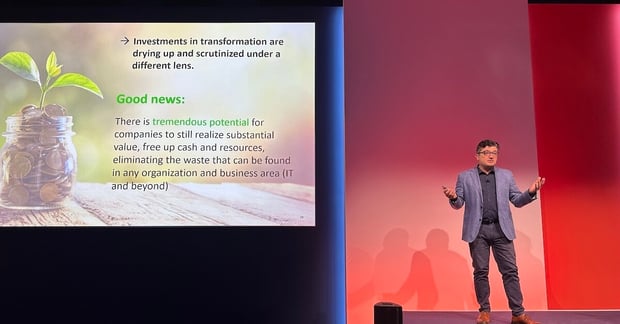
Reckitt uses the LeanIX platform to gain clarity and insight into its application portfolio. Discover Reckitt's seven steps to business transformation with LeanIX.
On November 7, 2023, Reckitt Chief Information and Digital Officer (CIDO), Filippo Catalano, co-presented a keynote with LeanIX founder and CEO, André Christ, at the Gartner 2023 EMEA IT Symposium/Xpo in Barcelona, Spain. Filippo's section of the talk explained how Reckitt uses a seven-step process to complete business transformations using the LeanIX platform.
To find out more about how LeanIX supports business transformation, read our free whitepaper on leveraging LeanIX to support an enterprise resource planning (ERP) transformation:
FREE WHITEPAPER: Getting It Right - A Holistic Approach To SAP S/4HANA transformations
The Value Of Business Transformation
The market is facing tremendous turmoil from recent events. Among the challenges facing enterprise, Filippo listed:
- Inflation
- Geopolitical instability
- Supply chain complexity and uncertainty
- Input cost/commodities
- Cost of capital/interest rates
- Transformation cost/energy/sustainability
- Employee engagement/talent
As a result, investments in transformation are drying up. This is because business cases are being scrutinized under a different lens.
Thankfully, there is some good news: there's still tremendous potential to gain buy-in for business transformation as a cost-reduction effort that realizes substantial value.
To that end, Filippo followed a seven-step plan to achieving business transformation success at Reckitt. Let's review each of the seven steps.
Step 1: Establish Priorities
Filippo explained that Reckitt has three priorities when it comes to business transformation:
- Core improvements to simplify and stabilize their foundations
- Value generation at a higher level and faster pace
- Innovation of the business model, including digital and artificial intelligence (AI) opportunities
Reckitt focuses on these activities at a 70/20/10 ration:
- 70% core
- 20% value
- 10% innovation
However, as time progresses and core stability improves, budget will be freed up to think about new market streams. This means you can spend more on value generation and technology innovation.
There's still a tremendous return on investment (ROI) from improving your core technology. Yet, value creation and innovation are your competitive advantage in a fast-paced market.
As such, your goal is to build strong foundations so you can focus on driving innovation with new technology. This is how Reckitt makes progressive steps towards continuous business transformation.
Step 2: Gamify Buy-In
Reckitt's innovative approach to getting buy-in from their organization on their transformation efforts was to run a Kill An App competition. A challenge went out across Reckitt with a prize for anyone who could find and nominate a software application that could be easily retired.
This served to show the value of what Filippo's team were trying to achieve, and also make participation fun for those involved. Best of all, it helped build an internal expert community within Reckitt.
By the end of the two-week challenge, Filippo had acquired:
- 46 application "hunters"
- 162 nominations for applications to "kill"
- 239 votes supporting the retirement of applications
Step 3: Map Your Landscape
Once you've established your priorities and gained buy-in on your project, it's next key to understand your current state. This involves cataloging your application portfolio and gaining clarity on your usage, spend, and dependencies.
Once you do so, it should be immediately clear where you can eliminate inefficiencies and unnecessary spend. This allows you to unlock instant return on transformation investment as confirmation of success.
From there, your goal is to simplify and organize your application portfolio and core technology. This will accelerate future transformations and drive long-term value.
Step 4: Bundle And Unbundle
Filippo explained that your simplification efforts comprise two different actions, depending on the circumstances:
1 Bundle
Where multiple business capabilities can be fulfilled by one application, you will likely find a reduction in cost and complexity in making the switch. Gathering lone capabilities into a single application is often valuable.
2 Unbundle
Conversely, it's common to be overzealous in gathering applications until you're eventually working with a single, monolithic stack that isn't flexible enough to suit your needs. In this case, it may be easier to break down those capabilities into dedicated applications.
These two activities may seem contradictory. However, the goal is to keep your application portfolio in the sweet spot between too many individual applications and an inflexible monolith.
Step 5: Anticipate Change
Once you've eliminated unnecessary spend and cut back on complexity, it's time to think about the future. Consider supporting future transformations and plan out a road map to ensure you have plenty of runway for coming change.
It's also important to build governance into your process to ensure your plan is followed and you don't lose oversight. An Excel spreadsheet isn't sufficient for this, as you need the live data and automated processes offered in the LeanIX platform.
Step 6: Drive Efficiency
Once your transformation is complete, your job still isn't over. You need to continually monitor your IT landscape and immediately respond to inefficiencies.
Measure your wastage and level of automation as a proxy for modernization. Your goal is to ruthlessly drive continuous improvement across both metrics.
Step 7: Build A Product Catalog
In addition to your application portfolio, having a detailed product catalog helps build transparency and visibility for available products. Crucially, it also discourages duplication of effort in product creation.
Remember that the hierarchy of your product catalog is a reflection of your overall strategy. Having this in order also increases visibility on your strategic goals.
Put It All In A LeanIX Road Map
Reckitt is a LeanIX customer and uses our platform to catalog and document its application portfolio and IT landscape. Reckitt uses LeanIX to gain clarity to drive each of the seven steps above.
To find out more about how LeanIX can help you drive forward your business transformations, download our free whitepaper for an example of our approach:


